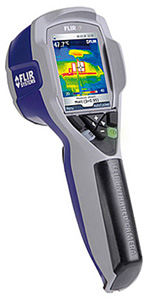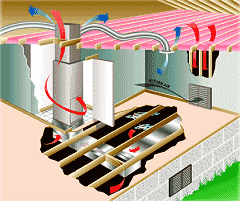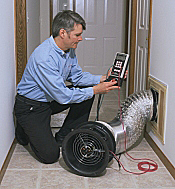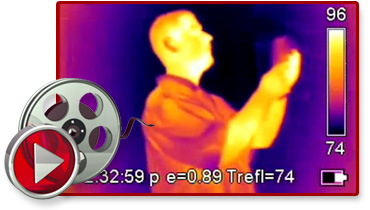
BPS's Home Energy Audit Process BPS's Thermal Imaging (Infrared Thermography) Infrared Thermography is the use of an infrared imaging and measurement device to "see" and measure thermal energy emitted from an object. Thermal or infrared energy, is light which is not visible because its wavelength is too long to be detected by the human eye: it's the part of the electromagnetic spectrum we perceive as "heat".
BPS's High-Technology Solution
Unlike visible light, in the infrared world, everything with a temperature above absolute zero (minus 459 degrees F) emits heat. Even very cold objects, like ice cubes emit infrared. The higher the object's temperature, the more infrared energy is emitted.
 Infrared imaging equipment allows us to see what our eyes can not. Infrared thermographic cameras produce images of invisible infrared or "heat" radiation and provide precise non-contact temperature measurement capabilities.
Infrared imaging equipment allows us to see what our eyes can not. Infrared thermographic cameras produce images of invisible infrared or "heat" radiation and provide precise non-contact temperature measurement capabilities.
Nearly everything gets hot before it fails, making infrared inspections extremely cost-effective, valuable diagnostic tools in diverse applications.
Commercial and Industrial firms have been using Thermal Imaging for some time to predict which of their critical electrical and mechanical components are likely to fail and to verify their buildings energy efficiency.
With the high cost of energy today, homeowners and small business' should also use Thermal Scans for energy savings, moisture detection (leading to mold in some cases), and especially for electrical panel inspections that can detect potential fire hazards from bad connections, overloaded circuits and more. BPS's Duct Leakage Testing Is There a Thief in Your Ductwork? There are more than a million miles of duct work in U.S. homes. And industry experts estimate that more than two-thirds of them are leaky enough to justify sealing or repair. Leaky ducts can significantly increase air conditioning and heating bills, dramatically reduce equipment capacity and performance, as well as result in potentially dangerous indoor air quality problems. In fact, duct leakage is responsible for many of the comfort complaints experienced by homeowners today.
Why Is Duct Leakage Important?
Leaks in forced air duct systems are now recognized as a major source of energy waste in both new and existing houses. Studies indicate that duct leakage can account for as much as 25% of total house energy loss, and in many cases has a greater impact on energy use than air infiltration through the building shell. Just as important, duct leakage can prevent heating and cooling systems from doing their job properly, resulting in hot or cold rooms, and humidity problems. Worse yet, duct leaks can create air quality problems by pulling pollutants and irritants directly into the house.
Here are just a few of the problems resulting from duct leakage:
A BPS duct leakage performance test involves pressurizing the duct system with a calibrated fan and simultaneously measuring the air flow through the fan and its effect on the pressure within the duct system. The tighter the duct system, the less air you need from the fan to create a change in duct system pressure. Testing procedures can be set up to measure only duct leaks which are connected to the outside, or to measure total duct leakage ( i.e. leaks connected to the outside and inside of the house). Duct leakage measurements are used to diagnose and demonstrate leakage problems, estimate efficiency losses from duct leakage, and certify the quality of duct system installation.
Two different types of performance testing systems are used to measure duct leakage; a Duct Blaster® and a Blower Door.
Duct Blaster®
Insulation Experts Visit our Insulation website for more in depth information Without proper air sealing, a building can lose a great deal of its efficiency through air leakage. It's one of the primary causes of hot and cold spots that can cause discomfort for owners. But as with any building product, insulation is only as effective as its installation and where it's applied. Spray foam is only installed by qualified contractors. That's why builders are choosing Spray foam to insulate their homes.
Stop by and learn all about the Science of Building Performance at ComfortToLife.com
BPS's High-Technology Solution
Unlike visible light, in the infrared world, everything with a temperature above absolute zero (minus 459 degrees F) emits heat. Even very cold objects, like ice cubes emit infrared. The higher the object's temperature, the more infrared energy is emitted.
 Infrared imaging equipment allows us to see what our eyes can not. Infrared thermographic cameras produce images of invisible infrared or "heat" radiation and provide precise non-contact temperature measurement capabilities.
Infrared imaging equipment allows us to see what our eyes can not. Infrared thermographic cameras produce images of invisible infrared or "heat" radiation and provide precise non-contact temperature measurement capabilities. Nearly everything gets hot before it fails, making infrared inspections extremely cost-effective, valuable diagnostic tools in diverse applications.
Commercial and Industrial firms have been using Thermal Imaging for some time to predict which of their critical electrical and mechanical components are likely to fail and to verify their buildings energy efficiency.
With the high cost of energy today, homeowners and small business' should also use Thermal Scans for energy savings, moisture detection (leading to mold in some cases), and especially for electrical panel inspections that can detect potential fire hazards from bad connections, overloaded circuits and more. BPS's Duct Leakage Testing Is There a Thief in Your Ductwork? There are more than a million miles of duct work in U.S. homes. And industry experts estimate that more than two-thirds of them are leaky enough to justify sealing or repair. Leaky ducts can significantly increase air conditioning and heating bills, dramatically reduce equipment capacity and performance, as well as result in potentially dangerous indoor air quality problems. In fact, duct leakage is responsible for many of the comfort complaints experienced by homeowners today.
Why Is Duct Leakage Important?
Leaks in forced air duct systems are now recognized as a major source of energy waste in both new and existing houses. Studies indicate that duct leakage can account for as much as 25% of total house energy loss, and in many cases has a greater impact on energy use than air infiltration through the building shell. Just as important, duct leakage can prevent heating and cooling systems from doing their job properly, resulting in hot or cold rooms, and humidity problems. Worse yet, duct leaks can create air quality problems by pulling pollutants and irritants directly into the house.
Here are just a few of the problems resulting from duct leakage:

- Leaks in the supply ductwork cause expensive conditioned air to be dumped into the attic, basement, crawlspace or garage instead of into the house.
- Return leaks pull outside air (hot in summer, cold in winter) into the duct system reducing both efficiency and capacity. In humid climates, moist air being drawn into return leaks can overwhelm the dehumidification capacity of air conditioning systems causing homes to feel clammy even when the air conditioner is running.
- Heat pumps are particularly susceptible to comfort complaints from duct leakage, especially during the heating season. Duct leaks can cause the air coming from heat pumps to feel luke-warm or even cold during the winter. In addition, leaky ductwork has been found to greatly increase the use of electric strip heaters in heat pumps during the heating season.
- Leaks in return ductwork draw air into the house from crawlspaces, garages and attics bringing with it dust, mold spores, insulation fibers and other contaminants.
- Household depressurization from duct leaks and imbalanced duct systems can cause spillage of combustion products (from furnaces, water heaters and fireplaces) into the house.
A BPS duct leakage performance test involves pressurizing the duct system with a calibrated fan and simultaneously measuring the air flow through the fan and its effect on the pressure within the duct system. The tighter the duct system, the less air you need from the fan to create a change in duct system pressure. Testing procedures can be set up to measure only duct leaks which are connected to the outside, or to measure total duct leakage ( i.e. leaks connected to the outside and inside of the house). Duct leakage measurements are used to diagnose and demonstrate leakage problems, estimate efficiency losses from duct leakage, and certify the quality of duct system installation.
Two different types of performance testing systems are used to measure duct leakage; a Duct Blaster® and a Blower Door.
Duct Blaster®

- A Duct Blaster® is used to directly pressure test the duct system for air leaks, much the same way a plumber pressure tests water pipes for leaks.
- The Duct Blaster® fan is first connected by BPS to the duct system at the air handler cabinet, or a return grille. After temporarily sealing all remaining registers and grills, the Duct Blaster® fan is turned on to force air through all holes and cracks in the ductwork.
- The fan speed is increased until a standard test pressure is achieved in the duct system. A precise leakage measurement is then made using an airflow and pressure gauge connected to the Duct Blaster® system.
- Estimates of efficiency losses from duct leakage can then be made from the leakage measurements.
- BPS recommends using a theatrical fog machine along with the Duct Blaster® to inject a non-toxic fog into the duct system to visually demonstrate the location and extent of leakage in the ductwork.
- The Blower Door is a whole house testing system which indirectly measures duct leakage by pressurizing the entire house to a standard testing pressure.
- BPS compares the whole house test before and after all registers are temporarily sealed, the Blower Door provides you with an estimate of duct leakage to the outside.
- With the Blower Door running, duct leaks can be pinpointed using a hand-held smoke puffer, or a leak detection tool called a pressure pan.
- In addition to diagnosing duct leakage problems, the Blower Door can identify building envelope improvements that will reduce energy use and increase comfort.
- Blower Door airtightness measurements can also be used in HVAC equipment design and sizing decisions, and to help estimate the need for mechanical ventilation.
Insulation Experts Visit our Insulation website for more in depth information Without proper air sealing, a building can lose a great deal of its efficiency through air leakage. It's one of the primary causes of hot and cold spots that can cause discomfort for owners. But as with any building product, insulation is only as effective as its installation and where it's applied. Spray foam is only installed by qualified contractors. That's why builders are choosing Spray foam to insulate their homes.
Stop by and learn all about the Science of Building Performance at ComfortToLife.com



